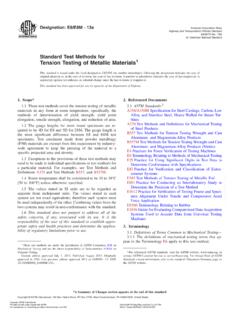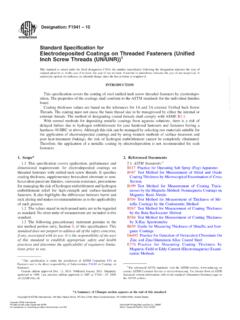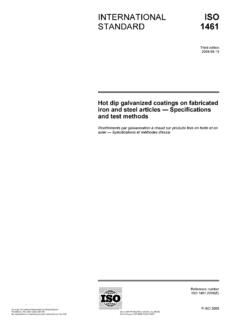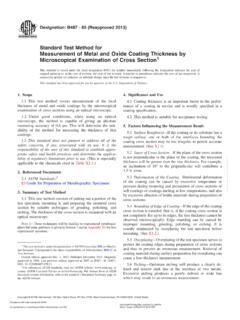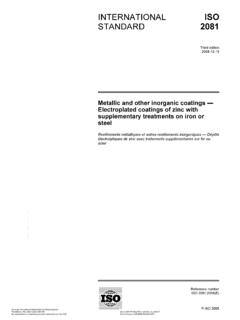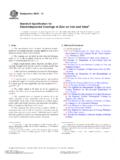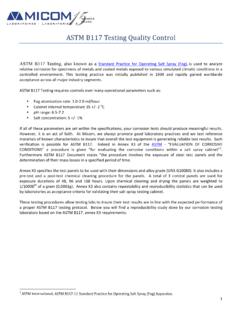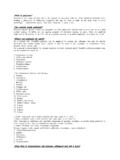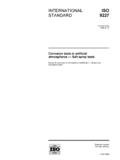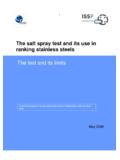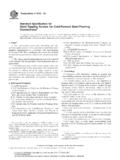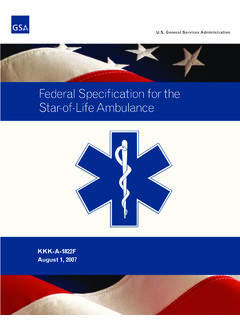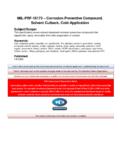Transcription of Standard Practice for Operating Salt Spray (Fog) …
1 Designation: B117 11. Standard Practice for Operating salt Spray (Fog) apparatus1 . This Standard is issued under the fixed designation B117; the number immediately following the designation indicates the year of original adoption or, in the case of revision, the year of last revision. A number in parentheses indicates the year of last reapproval. A. superscript epsilon ( ) indicates an editorial change since the last revision or reapproval. This Standard has been approved for use by agencies of the Department of Defense. 1. Scope* Determine the Precision of a Test Method This Practice covers the apparatus, procedure, and G85 Practice for Modified salt Spray (Fog) Testing conditions required to create and maintain the salt Spray (fog) 3. Significance and Use test environment. Suitable apparatus which may be used is described in Appendix X1. This Practice provides a controlled corrosive environ- This Practice does not prescribe the type of test speci- ment which has been utilized to produce relative corrosion men or exposure periods to be used for a specific product, nor resistance information for specimens of metals and coated the interpretation to be given to the results.
2 Metals exposed in a given test chamber. The values stated in SI units are to be regarded as the Prediction of performance in natural environments has Standard . The values given in parentheses are for information seldom been correlated with salt Spray results when used as only. stand alone data. This Standard does not purport to address all of the Correlation and extrapolation of corrosion perfor- safety concerns, if any, associated with its use. It is the mance based on exposure to the test environment provided by responsibility of the user of this Standard to establish appro- this Practice are not always predictable. priate safety and health practices and determine the applica- Correlation and extrapolation should be considered bility of regulatory limitations prior to use. only in cases where appropriate corroborating long-term atmo- spheric exposures have been conducted. 2. Referenced Documents The reproducibility of results in the salt Spray exposure ASTM standards :2 is highly dependent on the type of specimens tested and the B368 Test Method for Copper-Accelerated Acetic Acid- salt evaluation criteria selected, as well as the control of the Spray (Fog) Testing (CASS Test) Operating variables.
3 In any testing program, sufficient repli- D609 Practice for Preparation of Cold-Rolled Steel Panels cates should be included to establish the variability of the for Testing Paint, Varnish, Conversion Coatings, and results. Variability has been observed when similar specimens Related Coating Products are tested in different fog chambers even though the testing D1193 Specification for Reagent Water conditions are nominally similar and within the ranges speci- D1654 Test Method for Evaluation of Painted or Coated fied in this Practice . Specimens Subjected to Corrosive Environments 4. Apparatus E70 Test Method for pH of Aqueous Solutions With the Glass Electrode The apparatus required for salt Spray (fog) exposure E691 Practice for Conducting an Interlaboratory Study to consists of a fog chamber, a salt solution reservoir, a supply of suitably conditioned compressed air, one or more atomizing --`,`,`,,,`````,,`,`,,`,````,,`-`-`,,`,, `,`,,`--- nozzles, specimen supports, provision for heating the chamber, 1.
4 This Practice is under the jurisdiction of ASTM Committee G01 on Corrosion and necessary means of control. The size and detailed con- of Metals and is the direct responsibility of Subcommittee on Laboratory struction of the apparatus are optional, provided the conditions Corrosion Tests. Current edition approved Oct. 1, 2011. Published November 2011. Originally obtained meet the requirements of this Practice . approved in 1939. Last previous edition approved in 2009 as B117 09. DOI: Drops of solution which accumulate on the ceiling or 2. cover of the chamber shall not be permitted to fall on the For referenced ASTM standards , visit the ASTM website, , or contact ASTM Customer Service at For Annual Book of ASTM. specimens being exposed. standards volume information, refer to the Standard 's Document Summary page on Drops of solution which fall from the specimens shall the ASTM website. not be returned to the solution reservoir for respraying.
5 *A Summary of Changes section appears at the end of this Standard . Copyright ASTM International, 100 Barr Harbor Drive, PO Box C700, West Conshohocken, PA 19428-2959, United States. Copyright ASTM International Provided by IHS under license with ASTM. 1 Sold to:NW PA Reg Plann and Dev Co, 742768. No reproduction or networking permitted without license from IHS Not for Resale,12/08/2011 07:26:20 MST. B117 11. Material of construction shall be such that it will not Each specimen shall be placed to permit unencum- affect the corrosiveness of the fog. bered exposure to the fog. All water used for this Practice shall conform to Type IV salt solution from one specimen shall not drip on any water in Specification D1193 (except that for this Practice other specimen. limits for chlorides and sodium may be ignored). This does not NOTE 2 Suitable materials for the construction or coating of racks and apply to running tap water.
6 All other water will be referred to supports are glass, rubber, plastic, or suitably coated wood. Bare metal as reagent grade. shall not be used. Specimens shall preferably be supported from the bottom or the side. Slotted wooden strips are suitable for the support of flat 5. Test Specimens panels. Suspension from glass hooks or waxed string may be used as long The type and number of test specimens to be used, as as the specified position of the specimens is obtained, if necessary by well as the criteria for the evaluation of the test results, shall be means of secondary support at the bottom of the specimens. defined in the specifications covering the material or product 8. salt Solution being exposed or shall be mutually agreed upon between the The salt solution shall be prepared by dissolving 5 6 1. purchaser and the seller. parts by mass of sodium chloride in 95 parts of water 6. Preparation of Test Specimens conforming to Type IV water in Specification D1193 (except that for this Practice limits for chlorides and sodium may be Specimens shall be suitably cleaned.)
7 The cleaning ignored). Careful attention should be given to the chemical method shall be optional depending on the nature of the surface content of the salt . The salt used shall be sodium chloride with and the contaminants. Care shall be taken that specimens are not more than % by mass of total impurities. Halides not recontaminated after cleaning by excessive or careless (Bromide, Fluoride, and Iodide) other than Chloride shall handling. constitute less than % by mass of the salt content. Copper Specimens for the evaluation of paints and other organic content shall be less than ppm by mass. Sodium chloride coatings shall be prepared in accordance with applicable that has had anti-caking agents added shall not be used because specification(s) for the material(s) being exposed, or as agreed such agents may act as corrosion inhibitors. See Table 1 for a upon between the purchaser and the supplier. Otherwise, the listing of these impurity restrictions.
8 Upon agreement between test specimens shall consist of steel meeting the requirements the purchaser and the seller, analysis may be required and of Practice D609 and shall be cleaned and prepared for coating limits established for elements or compounds not specified in in accordance with the applicable procedure of Practice D609. the chemical composition given above. Specimens coated with paints or nonmetallic coatings The pH of the salt solution shall be such that when shall not be cleaned or handled excessively prior to test. atomized at 35 C (95 F) the collected solution will be in the Whenever it is desired to determine the development of pH range from to (Note 3). Before the solution is corrosion from an abraded area in the paint or organic coating, atomized it shall be free of suspended solids (Note 4). The pH. a scratch or scribed line shall be made through the coating with measurement shall be made at 23 6 3 C (73 6 5 F) using a a sharp instrument so as to expose the underlying metal before suitable glass pH-sensing electrode, reference electrode, and testing.
9 The conditions of making the scratch shall be as pH meter system in accordance with Test Method E70. pH. defined in Test Method D1654, unless otherwise agreed upon measurement shall be recorded once daily (except on week- between the purchaser and the seller. ends, or holidays when the salt Spray test is not interrupted for Unless otherwise specified, the cut edges of plated, exposing, rearranging, or removing test specimens or to check coated, or duplex materials and areas containing identification and replenish the solution in the reservoir. The maximum marks or in contact with the racks or supports shall be interval between pH measurements shall not exceed 96 h). protected with a suitable coating stable under the conditions of Only diluted, reagent grade hydrochloric acid (HCl) or reagent the Practice . grade sodium hydroxide (NaOH) shall be used to adjust the NOTE 1 Should it be desirable to cut test specimens from parts or from pH.
10 Preplated, painted, or otherwise coated steel sheet, the cut edges shall be protected by coating them with paint, wax, tape, or other effective media NOTE 3 Temperature affects the pH of a salt solution prepared from so that the development of a galvanic effect between such edges and the water saturated with carbon dioxide at room temperature and pH adjust- adjacent plated or otherwise coated metal surfaces, is prevented. ment may be made by the following three methods: (1) When the pH of a salt solution is adjusted at room temperature, and 7. Position of Specimens During Exposure atomized at 35 C (95 F), the pH of the collected solution will be higher than the original solution due to the loss of carbon dioxide at the higher The position of the specimens in the salt Spray chamber temperature. When the pH of the salt solution is adjusted at room during the test shall be such that the following conditions are temperature, it is therefore necessary to adjust it below so the collected met: solution after atomizing at 35 C (95 F) will meet the pH limits of to Unless otherwise specified, the specimens shall be Take about a 50-mL sample of the salt solution as prepared at room supported or suspended between 15 and 30 from the vertical temperature, boil gently for 30 s, cool, and determine the pH.

